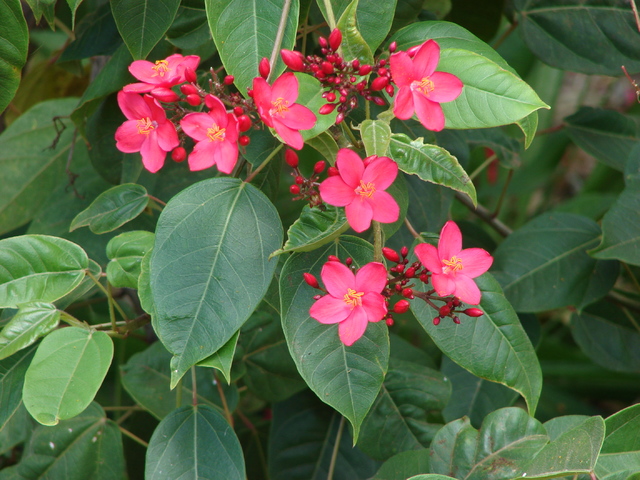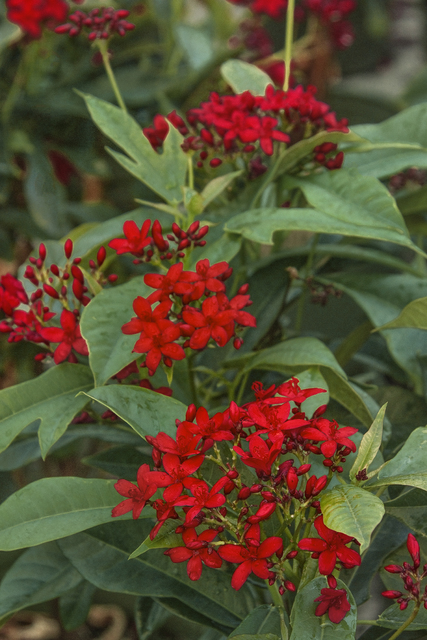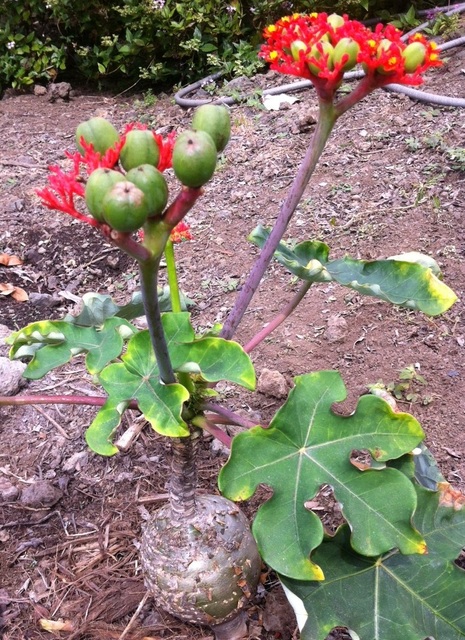Small flowering trees make lovely additions to landscapes in Hawaii. Though we have many choices, a few have characteristics that recommend them for multiple uses by Kona gardeners. The rose jatropha is one that can serve as a lovely single specimen, as well as grouped attractively in an informal hedge or screen, and it also grows well in a pot. Because this plant produces rose-colored flowers year-round, it will always attract attention regardless of its use or location.
Jatropha plants are all in the Euphorbiaceae or Spurge family which includes 170 different species. A few of these are commonly grown in Hawaii but Jatropha integerrima or rose jatropha is perhaps the most popular for landscape use. Most varieties have rosy pink flowers. One less common variety called spicy jatropha has red flowers and three-lobed leaves. Jatropha curcas is being researched as a potential biofuel producer and its oil is currently being used in diesel engines. Its abundant seeds contain nearly 35 percent oil on average and have been historically burned for light in the Philippines much like kukui nuts were used in old Hawaii. Jatropha podagrica is a succulent species characterized by its unusual shape and growth habit. Commonly known as gout plant, it has a lumpy swollen stem that produces large deeply lobed leaves and a tall flower stalk topped with a panicle of small bright red flowers that are followed by three-part seeds. This species is usually used as a single curious specimen in a garden or a pot.
Jatropha species are native to tropical and warm areas of Africa, Southern Asia and the Americas but none originated in Europe, Australia or the Pacific Islands. Rose jatropha is native to Cuba and the West Indies and is now grown worldwide. This species was brought to Hawaii from Panama in 1950 and is now used in home gardens, as well as shopping centers and other institutional landscapes. Like many other jatropha species, all parts of the rose jatropha are toxic, especially the seeds. It is not a good plant to use in areas where children or pets might eat the seeds.
Rose jatropha can be grouped as a screening plant or hedge and can tolerate some pruning to maintain an attractive shape. This plant does not adapt well to use as a trimmed hedge, however. When used as a single specimen, it is most attractive when the lower branches are removed revealing the slender trunk. The plant rarely grows more than 20 feet high and its lovely spreading crown can be encouraged by selective pruning. Most rose jatropha plants have long ovate leaves with pointed tips though some varieties have more interesting three-lobed leaves. The tree blooms year-round, producing 1-inch rose to bright red blossoms that are displayed in a cluster at the end of a short stalk. Rose jatropha flowers are not fragrant but are plentiful adding to the tree’s universal appeal. A small seed, the fruit of the rose jatropha, sometimes appears following flowering but its appearance is rare in Hawaii.
Rose jatropha will grow well at lower elevations in Kona and can be planted up to about 2,500 feet above sea level. It is somewhat wind tolerant and partially drought tolerant. It can be used as a xeriscape plant but it does not tolerate salt spray well.
Propagating rose jatropha from woody cuttings or herbaceous stems is fairly easy. If seeds appear, they can also be used to produce new plants. Cuttings will do best when dipped in a rooting compound and maintained with few or no leaves in a moist mix of perlite and vermiculite. Once new leaves appear and the cuttings seem firmly rooted, they can be re-potted or placed out in the garden.
Rose jatropha plants will do well in sunny locations and can tolerate partial shade. The plants can grow in a variety of soil types but good drainage is important. A fertile soil will encourage bushier growth. Deciding what shape you want your plant to take when it is young can help it become an attractive adult. You can choose to let it develop into a bushy shrub or to prune it to be a small tree. Making the decision early and following up with proper pruning will make the difference. Jatropha stems are delicate and easy to prune but their milky sap can cause allergic reactions in some people. It is a good plant to practice pruning techniques to create a desired form.
The fertility requirements of rose jatropha are minimal. Applying a small amount of a balanced fertilizer with micronutrients two or three times should keep your plant happy. To encourage flowering you should apply a small dose of fertilizer with a high potassium percentage occasionally. Heavy fertilizing with nitrogen will result in lots of stem and leaf production perhaps at the expense of flowering.
Pest problems are rare on jatropha. Occasional appearances of mites or aphids can be controlled with a combination of horticultural soap and neem oil. Recent reports of oleander scale and papaya mealybug appearing on jatropha can also be controlled with a soap and oil mix. Though neem oil can serve as a deterrent to insect pests, the soap-oil mix must contact the insects in order to kill them.
If you are looking for a small flowering tree to grace your garden, rose jatropha would be a wise choice.
Call around to see where you can get them. Sunrise Nursery currently has several in stock.
Diana Duff is a local organic farmer, plant adviser and consultant.











